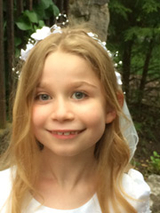Arterial Ischemic Stroke: Bella’s Story
Arterial Ischemic Stroke: Bella’s Story
Bella got off to a rocky start, facing a variety of serious medical scares in her first months of life, capped off with a stroke. It took a strong will for her to get to where she is today. Now 8 years old, she’s still calling on that same will and motivation that helped her survive as a baby to tackle every new dream and challenge.

Born six weeks prematurely at Doylestown Hospital, Bella had trouble breathing and suffered from a variety of medical problems. Three days after she was born, she was transferred to the Newborn/Infant Intensive Care Unit (N/IICU) at Children’s Hospital of Philadelphia (CHOP).
Over the next few weeks, Bella’s life hung in the balance. She had a chest tube and was put on an oscillating ventilator, a device that enables oxygenation without big swings in pressure within the lungs. After a few weeks, she was put on extracorporeal membrane oxygenation (ECMO), a heart-lung bypass system that provides long-term breathing and heart support for life-threatening conditions.
In the meantime, a mass of scar tissue on her right lung was collapsing Bella’s left lung and putting pressure on her heart. Surgery was performed to remove the upper and middle lobes of her right lung. That appeared to help — she was able to breathe, and the oxygen levels in her blood rose to healthy levels.
But Bella’s struggles weren’t over. She started having mild seizures, and one day they intensified. She was having a stroke.
Turning a corner

Bella had suffered an arterial ischemic stroke, which occurs when blood flow in the brain is blocked. The family had already worked with a number of specialists in their time at CHOP. Now they began new relationships with Rebecca Ichord, MD, a Pediatric Neurologist and Director of CHOP’s Pediatric Stroke Program, and a team of occupational, physical and educational therapists.
With her care being coordinated by the Stroke Program, Bella had access to all of the specialists she may need during her recovery, working together with a focus on minimizing damage from her stroke and preventing another. Once Bella was stable, the rehabilitation team began a structured series of exercises designed to help her recover from the effects of the stroke.
At first, Bella showed little response, but with help and guidance from the therapists, her mother, Karim, kept up the activities at Bella’s bedside. She would massage Bella and stimulate her mouth to encourage a sucking response. She would move her arms and legs to maintain their muscle tone.
Gradually, Bella began to respond. She was able to swallow, then suck on a finger or pacifier, then nurse a little. At first, she was getting all of her nutrition through a nasogastric (NG) tube. But as she began to nurse, the balance slowly shifted so that she needed less food through the tube, then none at all, and the tube was removed.
After two months at CHOP, Bella was released to go home.
Recovering at home
Karim worked diligently to continue Bella’s therapy at home, with help from Bucks County Early Intervention therapists and under the guidance of the medical team at CHOP, who coached Karim on techniques during follow-up appointments.
Bella soon recovered normal movement in her left side, but her right side took much more effort. Karim would put a sock with a bell sewn onto it on Bella’s right hand so she would notice it and make the connection between the tinkling sound and her own movements. She used a brush to stimulate Bella’s skin and revive her senses on her right side.
Walking proved difficult because of the lingering weakness on her right side. After a lot of hard work to build up strength, coordination and balance, Bella finally began to walk when she was 2. Karim still gets a thrill thinking of those first steps.
Making therapy fun
As Bella grew, Karim worked hard at making the therapy fun. For example, to make a squatting exercise feel like play, she had Bella move toys from the floor to the top story of a dollhouse.
“You have to bring joy into whatever it is you’re doing,” she says.
The approach worked. Bella had eight therapy sessions a week for five years and never complained or said she would rather do something else. Between her home therapy and regular follow-up visits to CHOP for PT, OT and speech therapy, she made great strides. By the time she started preschool, she had no trouble running, jumping and climbing with the other kids on the playground.
“She’s very motivated,” says Karim when reflecting on her daughter’s perseverance. “Strong-willed and positive. She’s my little light.”
School after stroke

These days, Bella is just like any other 8-year-old — she just needs to work a little harder at certain things.
For example, Bella continues to work on her physical coordination. Movements that come naturally to other children require extra thought and effort for her, but she doesn’t let that stop her from doing her favorite activities, like soccer, ballet and karate.
Bella also has to put extra effort towards organizational skills such as planning, focus and concentration. Despite these challenges, Bella is a builder. She loves to take things apart to see how they work, then find new ways of putting things back together again — activities that help her practice these cognitive skills. She’s already dreaming of becoming an engineer someday.
Elisa Olson, the Stroke Program’s Education Coordinator, has helped the family work with Bella’s school to accommodate her needs. Olson has come to meetings with Bella’s teachers, which have proven very helpful to everyone involved.
From the N/IICU to the classroom, Karim is grateful to CHOP for saving her daughter’s life, and for providing ongoing support and guidance ever since.
Published March 2017